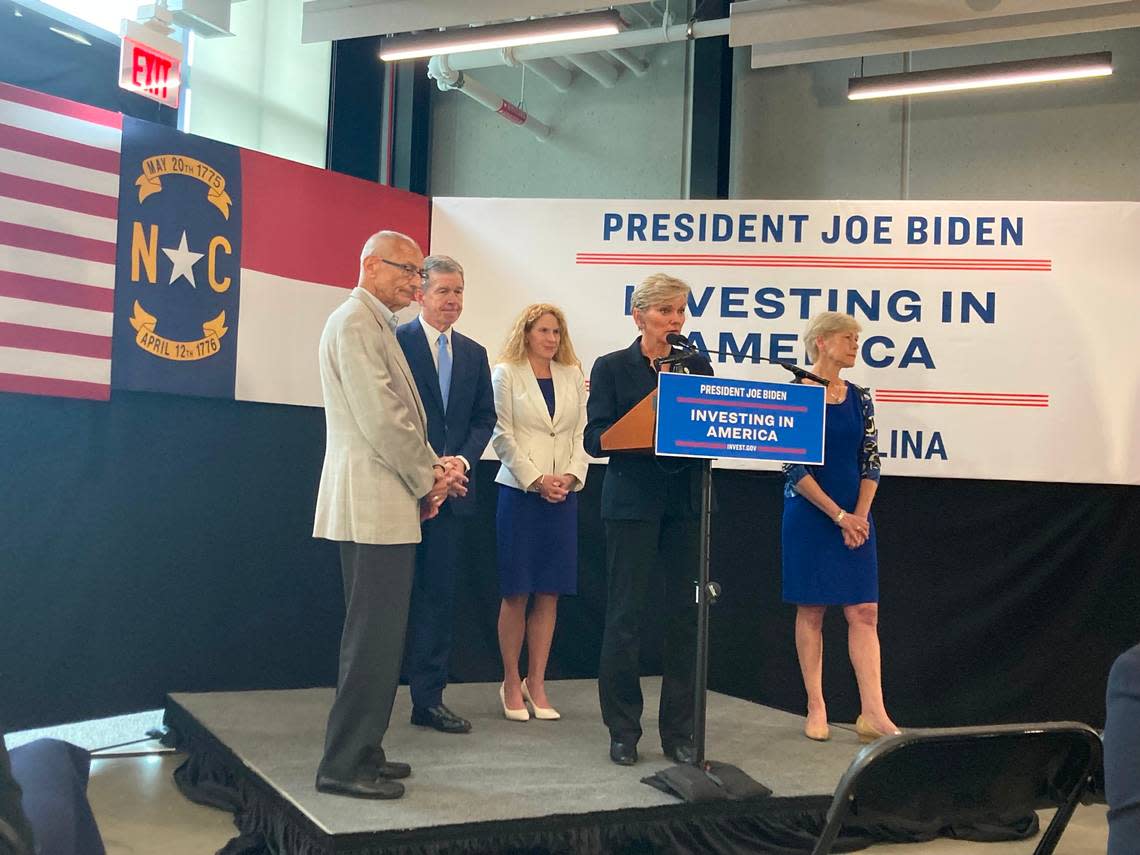A federal grant for a transmission line will help NC add solar power. Here’s how.

North Carolina is receiving a $57 million federal grant to replace an existing high-voltage transmission line in Eastern North Carolina, a step the U.S. Department of Energy said is intended to boost grid resilience.
The Lee-Milburnie transmission line runs between Raleigh and Goldsboro, carrying 230 kilovolt power. Duke Energy will foot half of the bill for the project, with the Department of Energy grant paying for the other half.
Upgrading the power line will help bring more renewable energy projects online, Duke officials said Tuesday during an event in Garner. Creating additional space on the transmission line will allow the company to move forward with additional solar energy projects in Southeastern North Carolina, adding capacity for the energy produced there to be sent to the Triangle, where it is most needed.
The $57 million grant was one of eight projects the U.S. Department of Energy announced funding for on Tuesday, with the grants totaling $2.2 billion funded by the Bipartisan Infrastructure Law. In addition to the North Carolina project, those included $700 million for a 3,000-megawatt high voltage transmission line across North Dakota and Montana that connects three segments of the nation’s grid and $85 million to Virginia to install solar panels and battery storage to power a data center project.
Department of Energy Secretary Jennifer Granholm visited Duke Energy’s grid control center to announce the project, saying the funding will add 13 gigawatts of additional capacity to the grid across the country, as much as about 6.5 Hoover Dams.
Granholm focused on the North Carolina project’s ability to reduce the length of power outages and its ability to help people who depend on electric-powered medical devices. The project is expected cut down on the length of service outages by about 10% for about 14,000 Duke Energy customers.
“If you’ve got somebody who needs a machine to breathe, you can’t go eight hours with a blackout. You can’t go days, certainly you can’t go hours, often. So vulnerable (people) are demanding, and they should be, a reliant, reliable, resilient grid,” Granholm said.
Kendal Bowman, Duke Energy’s state president for North Carolina, told The News & Observer the transmission line would be held aloft by steel monopoles that can withstand stronger winds in hurricane-prone Eastern North Carolina while also taking up less space than the H-frame structures that currently line the Lee-Milburnie route.
Upgrading the transmission line will allow Duke to add 1,600 megawatts of solar energy and 250 megawatts of energy storage, according to a Department of Energy fact sheet.
“This is a high solar viability region where prior successful development and interconnection of solar facilities has consumed available capacity, leading to the need for extensive network transmission upgrades to facilitate further interconnection,” Dewey Roberts, Duke Energy’s general manager for transmission planning and operations strategy, said in a N.C. Utilities Commission filing last week..
The Lee-Milburnie line could also be one of several upgrades that eventually transports power from a wind farm off of North Carolina’s coast to the Triangle. TotalEnergies and unregulated Duke subsidiary Cinergy each hold wind leases off of the Brunswick County coast, but development is years away.
“This upgrade that we are making will allow us to essentially double the capacity of this line. And so when you do a study, it shows this line needs to be upgraded in order to get that offshore wind to the load (center),” Bowman said.
Duke would replace a single aluminum conductor line with advanced conductors, which have composite or carbon cores that can operate at higher temperatures and sag less than traditional transmission lines. A 2022 report prepared for the American Council on Renewable Energy said that allows advanced conductors to transmit additional energy during emergencies.
The new transmission lines will be built to sag less in hot temperatures, making them less susceptible to service interruptions. The project would take place in the existing line’s right-of-way, reducing the need for new permits and cutting down on potential concerns from the project’s neighbors.
Duke’s filing said that a cost-benefit analysis found that the project could offer more than $2.1 billion in benefits and could be in service as soon as December 2030.
The Lee-Milburnie project is an example of a process known as reconductoring, where utilities add transmission capacity by overhauling existing transmission lines instead of building new ones. In the Lee-Milburnie case, reconductoring offers savings of about 30%, which can add up quickly when projects run into the hundreds of millions of dollars.
A recent report from University of California, Berkeley, researchers and GridLab found that reconductoring can add about four times as much transmission capacity by 2035 as building new transmission lines. Such work would also allow the United States to shift much of its electricity generation to energy sources that do not emit greenhouse gases, the report found.
“It’s part of the process, so when we show we need growth from a reliability standpoint, when you’re thinking about planning, you look at: Can you reconductor? If you can’t reconductor or if the right of way doesn’t allow you to reconductor then you move to the next phase and that’s building a new line,” Bowman said.
This story was produced with financial support from the Hartfield Foundation and Green South Foundation, in partnership with Journalism Funding Partners, as part of an independent journalism fellowship program. The N&O maintains full editorial control of the work. If you would like to help support local journalism, please consider signing up for a digital subscription, which you can do here.
